Royal Caribbean Bundle
How Did Royal Caribbean Become a Cruise Industry Titan?
Embark on a voyage through time to discover the remarkable Royal Caribbean SWOT Analysis and the captivating Royal Caribbean history. From its humble beginnings in 1968, this global cruise giant has revolutionized the cruise industry. Explore the pivotal moments that shaped Royal Caribbean International into the industry leader it is today.
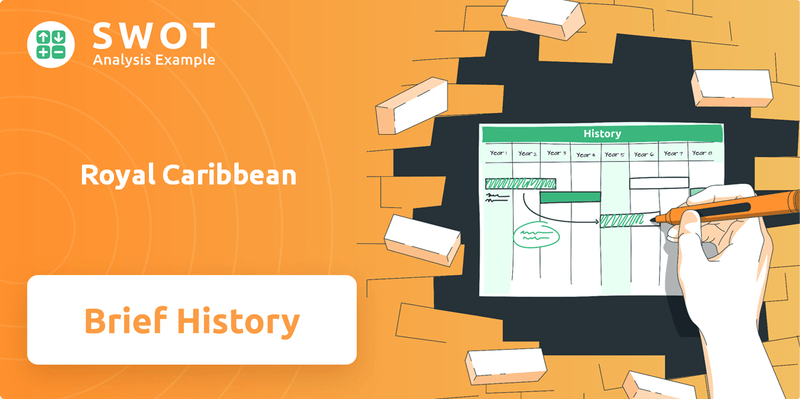
The Cruise line history of Royal Caribbean is a testament to visionary leadership and relentless innovation. From the early days of Royal Caribbean, with its first cruise offerings, to its current fleet of state-of-the-art ships, the company has consistently pushed boundaries. Understanding Royal Caribbean's founding and key milestones provides valuable insights into its strategic evolution and enduring success, offering a fascinating look at RCCL's journey.
What is the Royal Caribbean Founding Story?
The story of Royal Caribbean, a major player in the cruise industry, began in 1968. It was a collaborative venture, born from the vision of three Norwegian shipping companies: Anders Wilhelmsen & Company, I.M. Skaugen & Company, and Gotaas Larsen. Edwin Stephan, a hospitality entrepreneur, also played a crucial role in bringing the company to life. This marked the start of a new era in leisure travel.
The founders saw an opportunity to transform cruising. Their goal was to offer year-round Caribbean cruises departing from Florida. This was a shift from the traditional model of ocean crossings or long, expensive voyages. Their initial focus was on providing innovative cruise experiences with high service standards. This set the stage for what Royal Caribbean would become.
The primary product was the cruise experience itself, focusing on leisure travel. The company's first ship, the Song of Norway, set sail from Miami on November 7, 1970. The name 'Royal Caribbean' was chosen to signal the high service standards. The early ships were designed for speed and efficiency, allowing access to smaller ports.
- The company's initial headquarters was in a trailer on Biscayne Boulevard in Miami.
- The Song of Norway's maiden voyage marked a significant milestone in
. - The early focus was on providing a new type of vacation experience.
- The company's growth was fueled by its innovative approach to cruising.
In its early years, Royal Caribbean International (RCCL) focused on building a reputation for quality and innovation. The design of the early ships reflected the advanced Norwegian marine industry, emphasizing efficiency and access to various ports. This strategic approach helped the company establish a strong foundation in the burgeoning cruise industry. The company's early success set the stage for its future expansion and its impact on the cruise line history.
Royal Caribbean SWOT Analysis
- Complete SWOT Breakdown
- Fully Customizable
- Editable in Excel & Word
- Professional Formatting
- Investor-Ready Format
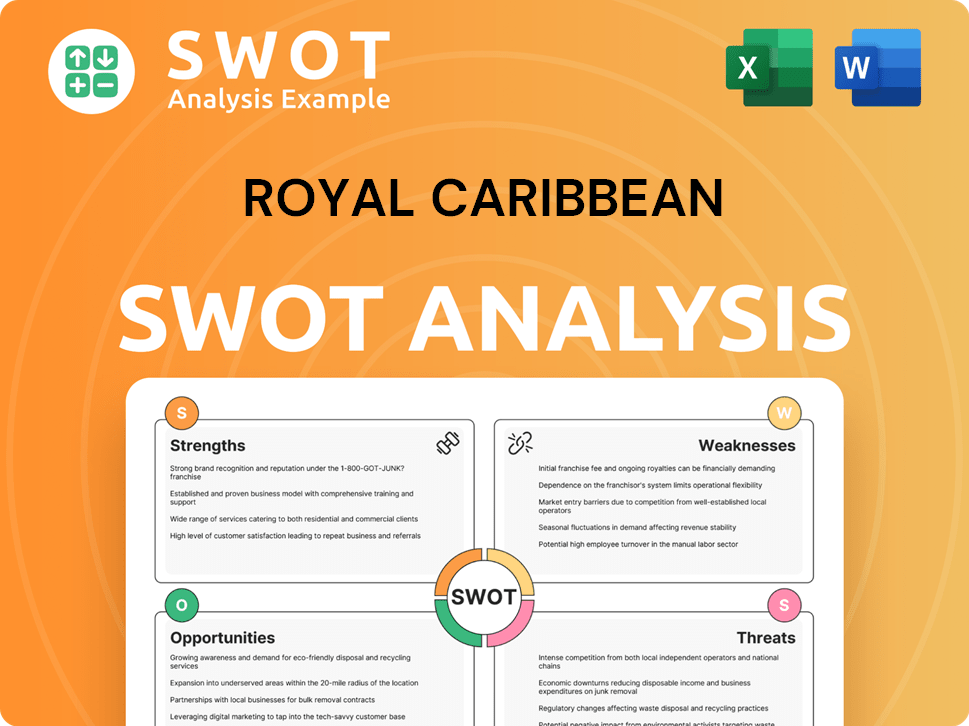
What Drove the Early Growth of Royal Caribbean?
The early years of the cruise line, now known as Royal Caribbean, were marked by rapid expansion and innovation within the cruise industry. Following its initial launch, the company quickly grew its fleet and introduced features that would define the cruise experience. This period saw the development of signature elements and strategic acquisitions that solidified its position in the market.
The Royal Caribbean launched its first ship, Song of Norway, in November 1970, quickly followed by Nordic Prince in 1971 and Sun Viking in 1972. These early vessels were pivotal in establishing the company's brand. They featured open-air decks and the Viking Crown Lounges, setting a new standard for cruise ship design.
A significant innovation was the 'stretching' of the Song of Norway in 1978, which increased its guest capacity from 700 to over 1,000. The Nordic Prince underwent a similar expansion in 1980. These modifications allowed the cruise line to accommodate more passengers and increase its profitability.
In 1982, the company launched Song of America, a larger cruise ship, which was twice the size of Sun Viking. By 1986, it leased Labadee and acquired Little Stirrup Cay (now CocoCay) in 1988, creating exclusive destinations for its guests. These moves enhanced the overall cruise experience and provided unique selling points.
The year 1988 marked a corporate restructuring where Anders Wilhelmsen & Company gained full ownership. The launch of Sovereign of the Seas in 1988 introduced the 'megaship' concept. The early 1990s saw the delivery of Monarch of the Seas in 1991 and Majesty of the Seas in 1992. The cruise line went public on the New York Stock Exchange in 1993.
Royal Caribbean PESTLE Analysis
- Covers All 6 PESTLE Categories
- No Research Needed – Save Hours of Work
- Built by Experts, Trusted by Consultants
- Instant Download, Ready to Use
- 100% Editable, Fully Customizable
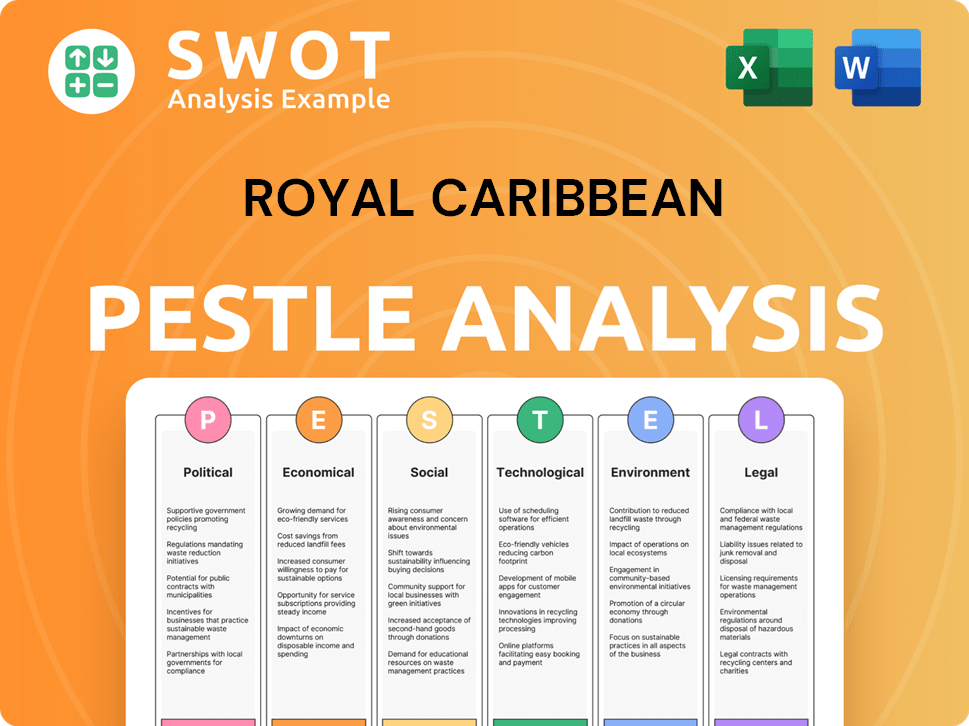
What are the key Milestones in Royal Caribbean history?
The Royal Caribbean has a rich cruise line history, marked by significant milestones in the cruise industry. The company's journey began with its founding and has since evolved through strategic acquisitions and innovative developments, significantly impacting the cruising experience.
| Year | Milestone |
|---|---|
| 1997 | Royal Caribbean Cruise Line merged with Celebrity Cruises, forming Royal Caribbean Cruises Ltd. as a holding company. |
| 2007 | Royal Caribbean acquired a 50% stake in TUI Cruises, expanding its market reach. |
| 2018 | The company acquired Silversea Cruises, further diversifying its brand portfolio. |
| 2024 | Launched the Icon of the Seas, the world's largest cruise ship, and the Utopia of the Seas, focusing on weekend getaways. |
Royal Caribbean International has consistently introduced groundbreaking innovations. These include features like rock-climbing walls, ice-skating rinks, and zip lines, transforming the onboard experience.
Royal Caribbean was the first to introduce a rock-climbing wall on a cruise ship, offering a unique recreational activity. This innovation set a new standard for onboard entertainment, attracting adventure-seeking passengers.
The company also pioneered the inclusion of an ice-skating rink on a cruise ship. This feature provided passengers with a novel and exciting entertainment option, enhancing the overall cruise experience.
Royal Caribbean introduced the first zip line over water, adding an adventurous element to the cruise experience. This innovation provided guests with a thrilling activity, further differentiating its offerings in the market.
Royal Caribbean developed private destinations, such as Perfect Day at CocoCay. This private island offers exclusive experiences, significantly boosting passenger satisfaction and repeat bookings.
The introduction of the Icon class ships represents a major innovation in ship design and passenger experience. These ships are designed to offer a variety of new amenities and features, setting new standards in the cruise industry.
The launch of the Utopia of the Seas in July 2024, specializing in weekend getaways, highlights the company's focus on offering diverse cruise options. This ship caters to travelers looking for shorter, more accessible cruise experiences.
Despite its successes, Royal Caribbean has faced challenges. The company had to navigate global market downturns and the COVID-19 pandemic, which significantly impacted its operations.
Royal Caribbean has had to manage the impacts of economic downturns, which can affect consumer spending on leisure travel. These periods require strategic financial planning and operational adjustments to maintain profitability.
The COVID-19 pandemic presented unprecedented challenges, leading to a complete shutdown of the cruise industry. This situation necessitated significant debt to sustain operations during the crisis, impacting the company's financial stability.
The company has demonstrated resilience, as it exceeded its 2019 profit and passenger levels in 2024. This recovery was supported by strategic measures, including moderate capacity and yield growth, as well as strong cost discipline.
The reinstatement of its dividend is a key indicator of Royal Caribbean's financial recovery and confidence in its future performance. This move reflects the company's improved financial health and commitment to shareholders.
The company's focus on moderate capacity growth, yield growth, and cost discipline has been crucial to its financial strength. These strategies have enabled Royal Caribbean to navigate challenges and achieve sustainable growth.
Royal Caribbean continues to expand into new markets and enhance its offerings to meet evolving consumer preferences. This includes targeting new demographic groups and developing innovative cruise experiences to stay competitive.
For more insights into the company's core values and mission, explore the Mission, Vision & Core Values of Royal Caribbean.
Royal Caribbean Business Model Canvas
- Complete 9-Block Business Model Canvas
- Effortlessly Communicate Your Business Strategy
- Investor-Ready BMC Format
- 100% Editable and Customizable
- Clear and Structured Layout
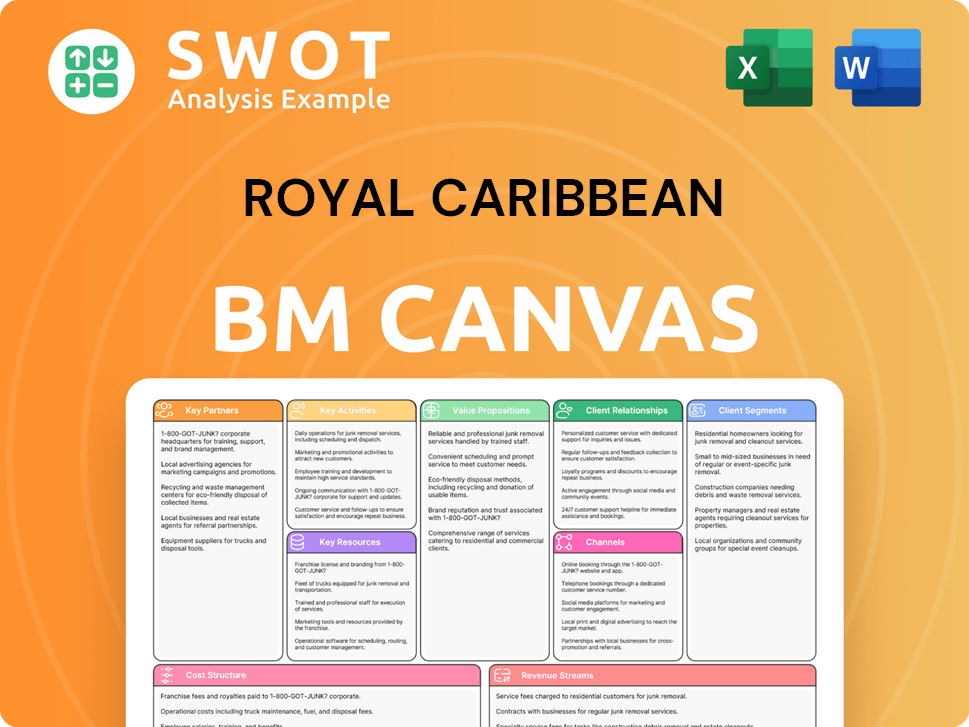
What is the Timeline of Key Events for Royal Caribbean?
The Royal Caribbean story showcases significant growth and innovation within the cruise industry. From its inception in 1968 to becoming a global leader, the company has consistently adapted and expanded, setting new standards in the cruise line history.
| Year | Key Event |
|---|---|
| 1968 | Royal Caribbean Cruise Line is founded by Norwegian shipping companies. |
| 1970 | The first ship, Song of Norway, begins its maiden voyage from Miami. |
| 1978 | Song of Norway becomes the first passenger ship to be lengthened. |
| 1986 | Royal Caribbean leases Labadee, its first exclusive private destination. |
| 1988 | The company merges with Admiral Cruises and launches Sovereign of the Seas. |
| 1993 | Royal Caribbean goes public on the New York Stock Exchange. |
| 1997 | Royal Caribbean Cruise Line merges with Celebrity Cruises, forming Royal Caribbean Cruises Ltd. |
| 2007 | Royal Caribbean Group acquires a 50% stake in TUI Cruises. |
| 2018 | Silversea Cruises joins the Royal Caribbean Group portfolio. |
| 2020 | The company adopts the new moniker, Royal Caribbean Group. |
| 2024 | Icon of the Seas, the world's largest cruise ship, debuts. Royal Caribbean Group reports total revenues of $16.5 billion and Adjusted EPS of $11.80. |
Royal Caribbean Group anticipates continued financial growth. The company expects Adjusted EPS to be in the range of $14.35 to $14.65. Capacity is projected to increase by 5.5% compared to 2024, with the delivery of Star of the Seas and Celebrity Xcel.
The company aims to achieve its 'Trifecta' goals by the end of 2025. These include an Adjusted EBITDA per APCD of at least $100, Adjusted EPS of at least $10, and an ROIC of 13% or higher. Net Yields are expected to increase by 2.5% to 4.5% in constant currency for the full year 2025.
Capital expenditures for 2025 are projected at approximately $5 billion. These investments primarily target new ship orders and land-based destination initiatives. Beyond 2025, capacity changes are expected to be 6% in 2026, 5% in 2027, and 6% in 2028, driven by new ship deliveries.
Royal Caribbean Group plans to expand its offerings. The company is set to open additional private resorts in Cozumel and Costa Maya in Mexico, and on Lelpea Island, Vanuatu. Celebrity River Cruises is announced with plans for bookings to begin in 2025.
Royal Caribbean Porter's Five Forces Analysis
- Covers All 5 Competitive Forces in Detail
- Structured for Consultants, Students, and Founders
- 100% Editable in Microsoft Word & Excel
- Instant Digital Download – Use Immediately
- Compatible with Mac & PC – Fully Unlocked
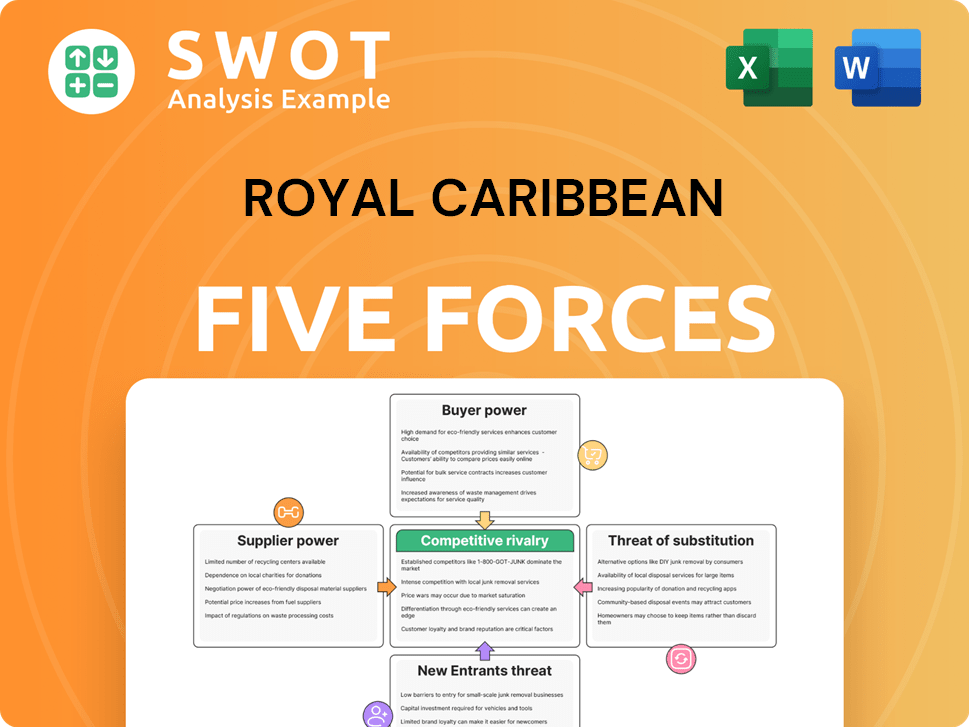
Related Blogs
- What is Competitive Landscape of Royal Caribbean Company?
- What is Growth Strategy and Future Prospects of Royal Caribbean Company?
- How Does Royal Caribbean Company Work?
- What is Sales and Marketing Strategy of Royal Caribbean Company?
- What is Brief History of Royal Caribbean Company?
- Who Owns Royal Caribbean Company?
- What is Customer Demographics and Target Market of Royal Caribbean Company?
Disclaimer
All information, articles, and product details provided on this website are for general informational and educational purposes only. We do not claim any ownership over, nor do we intend to infringe upon, any trademarks, copyrights, logos, brand names, or other intellectual property mentioned or depicted on this site. Such intellectual property remains the property of its respective owners, and any references here are made solely for identification or informational purposes, without implying any affiliation, endorsement, or partnership.
We make no representations or warranties, express or implied, regarding the accuracy, completeness, or suitability of any content or products presented. Nothing on this website should be construed as legal, tax, investment, financial, medical, or other professional advice. In addition, no part of this site—including articles or product references—constitutes a solicitation, recommendation, endorsement, advertisement, or offer to buy or sell any securities, franchises, or other financial instruments, particularly in jurisdictions where such activity would be unlawful.
All content is of a general nature and may not address the specific circumstances of any individual or entity. It is not a substitute for professional advice or services. Any actions you take based on the information provided here are strictly at your own risk. You accept full responsibility for any decisions or outcomes arising from your use of this website and agree to release us from any liability in connection with your use of, or reliance upon, the content or products found herein.